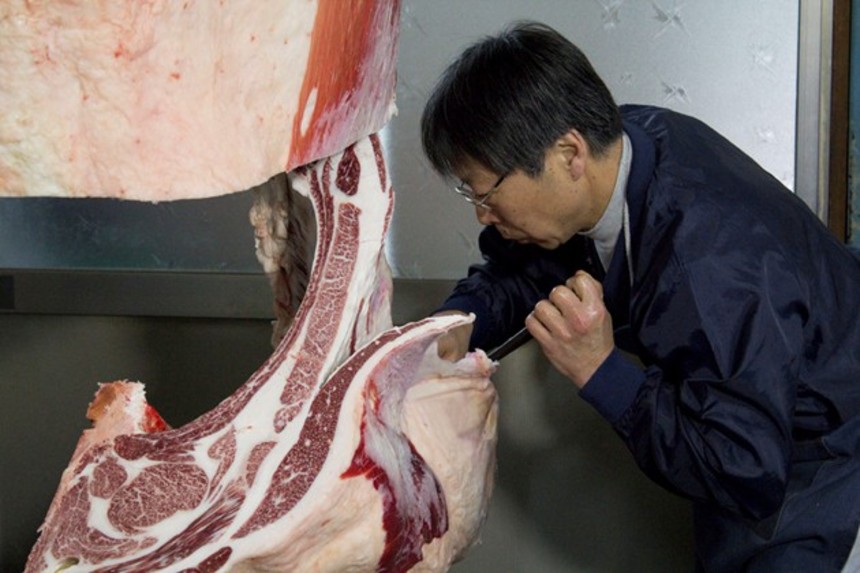Japan Cuts 2014 Review: TALE OF A BUTCHER SHOP, A Sensitively Observed Documentary Of A Working-Class Family

Tale of a Butcher Shop, Hanabusa Aya's sensitively observed documentary on a family of butchers in Kaizuka City in Osaka, Japan, begins in a very startling fashion, with an unflinching depiction of a cow's slaughtering. A man leads the cow carefully down a road to a slaughterhouse, and after he places the cow in position, another man brings it down with a blow to its head from a spiked hammer, killing it instantly. After that, blood is drained from its body, and other members of the family skin it and carve it up in preparation for processing. A narrator talks us through the process, describing how not a single part of the cow is wasted; every part of its body, down to its gristle and bowels, is usable for food or other purposes.
This visceral opening ensures that the practice of animal slaughter is not rendered here as an abstract idea, but one of literal flesh and blood. It also sets things up for the film's deeper historical inquiry into how societal discrimination has impacted the family of butchers that are the film's subject. This elevates the film well above a simple, gentle sketch of local culture, to become a fascinating story of the passing of an era, as well as an inspiring story of resilience and resistance against historically enforced marginalization.
The Kitade family has been running their butcher and meat processing business for seven generations, using a 102-year old slaughterhouse that is about to be shut down. The Kitades own one of the few businesses left that is an all-purpose operation, slaughtering, processing, and selling their meat. The standard industrial practice nowadays is to have those functions performed by separate entities. Because of this mass production, the Kitades' customer base has dwindled and now largely consists of older customers. Some of the family members have branched out into other businesses as a source of additional income. Akira, one of the men in the family, has begun tanning cowhide to make drums and teaches classes on traditional drum making. These drums are used in local festivals and other celebrations.
The film also delves into the Kitade family history, and how they were discriminated against as buraku, a low societal class who usually handled such tasks as animal butchery and others that were considered unclean, although of course these were necessary to society as a whole. This designation of buraku was a holdover from the feudal caste system that was abolished by the 19th century and the coming of the Meiji era. However, the buraku continued to suffer the stigma of being of this low class, and its accompanying societal marginalization, such as not being allowed to go to school, being restricted to live in designated ghettoized areas, where they were provided with fewer resources and subjected to substandard living conditions.
The Kitades were active in the Buraku Liberation Movement, a civil-rights movement that fought for equal rights for the buraku and fought for greater access to resources such as education and housing, as well as greater acceptance by society in general. Through this involvement in the movement, the Kitades were able to gain more pride and assert themselves in establishing their worth and value to society. Stigmatization and prejudice persist to the present day however, especially from older people. One Kitade relative talks of how his fiancé's parents disapprove of his intention to marry her, strictly because of his family background. He notes that the younger generation cares little about these societal distinctions.
Tale of a Butcher Shop may be more or less your standard, garden-variety sort of documentary, but its delicate powers of observation, as well as the deep respect shown for this hard-working and loving family, help to make it a very touching and finely observed film. There is a sense of melancholy you feel near the conclusion, when the closing of the slaughterhouse and the final cow to be butchered there coincides with the death of the family patriarch, who did so much to build the business into a beloved and respected part of the community. Even though the children say that he was a tough man who rarely showed affection for them, there still is a deep love for him that is exhibited at their father's memorial service.
After the funeral, the film ends on a more optimistic note, with a wedding and a symbolic "storming" of a local castle, where the wedding celebration partly takes place, a castle than in older days was the source of the authority that enforced their social oppression. This becomes a potent symbol of how times have changed for the better, even if these changing times have also posed a danger to the family's livelihood. The Kitades, however, continue to survive and thrive, through the old-fashioned, but still valuable virtues of hard work, pride in one's work, and familial love.

Do you feel this content is inappropriate or infringes upon your rights? Click here to report it, or see our DMCA policy.





